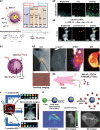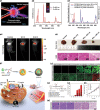Nanocomposites based on lanthanide-doped upconversion nanoparticles: diverse designs and applications
- PMID: 35831282
- PMCID: PMC9279428
- DOI: 10.1038/s41377-022-00871-z
Nanocomposites based on lanthanide-doped upconversion nanoparticles: diverse designs and applications
Abstract
Lanthanide-doped upconversion nanoparticles (UCNPs) have aroused extraordinary interest due to the unique physical and chemical properties. Combining UCNPs with other functional materials to construct nanocomposites and achieve synergistic effect abound recently, and the resulting nanocomposites have shown great potentials in various fields based on the specific design and components. This review presents a summary of diverse designs and synthesis strategies of UCNPs-based nanocomposites, including self-assembly, in-situ growth and epitaxial growth, as well as the emerging applications in bioimaging, cancer treatments, anti-counterfeiting, and photocatalytic fields. We then discuss the challenges, opportunities, and development tendency for developing UCNPs-based nanocomposites.
© 2022. The Author(s).
Conflict of interest statement
The authors declare no competing interests.
Figures











Similar articles
-
Engineered lanthanide-doped upconversion nanoparticles for biosensing and bioimaging application.Mikrochim Acta. 2022 Feb 17;189(3):109. doi: 10.1007/s00604-022-05180-1. Mikrochim Acta. 2022. PMID: 35175435 Review.
-
Combating Concentration Quenching in Upconversion Nanoparticles.Acc Chem Res. 2020 Feb 18;53(2):358-367. doi: 10.1021/acs.accounts.9b00453. Epub 2019 Oct 21. Acc Chem Res. 2020. PMID: 31633900
-
Controlled optical characteristics of lanthanide doped upconversion nanoparticles for emerging applications.Dalton Trans. 2017 Dec 12;46(48):16729-16737. doi: 10.1039/c7dt03049e. Dalton Trans. 2017. PMID: 29125162
-
Lab on upconversion nanoparticles: optical properties and applications engineering via designed nanostructure.Chem Soc Rev. 2015 Mar 21;44(6):1346-78. doi: 10.1039/c4cs00163j. Chem Soc Rev. 2015. PMID: 25052250
-
Self-Assembly of Upconversion Nanoparticles Based Materials and Their Emerging Applications.Small. 2022 Mar;18(9):e2103241. doi: 10.1002/smll.202103241. Epub 2021 Dec 1. Small. 2022. PMID: 34850560 Review.
Cited by
-
Nanoparticles in Cancer Diagnosis and Treatment.Materials (Basel). 2023 Jul 30;16(15):5354. doi: 10.3390/ma16155354. Materials (Basel). 2023. PMID: 37570057 Free PMC article. Review.
-
Utilizing Energy Transfer in Mn2+/Ho3+/Yb3+ Tri-doped ZnAl2O4 Nanophosphors for Tunable Luminescence and Highly Sensitive Visual Cryogenic Thermometry.ACS Omega. 2023 Aug 10;8(33):30459-30473. doi: 10.1021/acsomega.3c03629. eCollection 2023 Aug 22. ACS Omega. 2023. PMID: 37636912 Free PMC article.
-
Exploring the cytotoxic and antioxidant properties of lanthanide-doped ZnO nanoparticles: a study with machine learning interpretation.J Nanobiotechnology. 2024 Nov 10;22(1):687. doi: 10.1186/s12951-024-02957-9. J Nanobiotechnology. 2024. PMID: 39523303 Free PMC article.
-
A clenbuterol detection method based on magnetic separation up-conversion fluorescent probe.Food Chem X. 2024 Oct 21;24:101911. doi: 10.1016/j.fochx.2024.101911. eCollection 2024 Dec 30. Food Chem X. 2024. PMID: 39525055 Free PMC article.
-
Lanthanide ion-doped upconversion nanoparticles for low-energy super-resolution applications.Light Sci Appl. 2024 Sep 14;13(1):252. doi: 10.1038/s41377-024-01547-6. Light Sci Appl. 2024. PMID: 39277593 Free PMC article. Review.
References
-
- Lei PP, Feng J, Zhang HJ. Emerging biomaterials: taking full advantage of the intrinsic properties of rare earth elements. Nano Today. 2020;35:100952. doi: 10.1016/j.nantod.2020.100952. - DOI
-
- Zheng KZ, et al. Recent advances in upconversion nanocrystals: expanding the kaleidoscopic toolbox for emerging applications. Nano Today. 2019;29:100797. doi: 10.1016/j.nantod.2019.100797. - DOI
Publication types
Grants and funding
LinkOut - more resources
Full Text Sources

